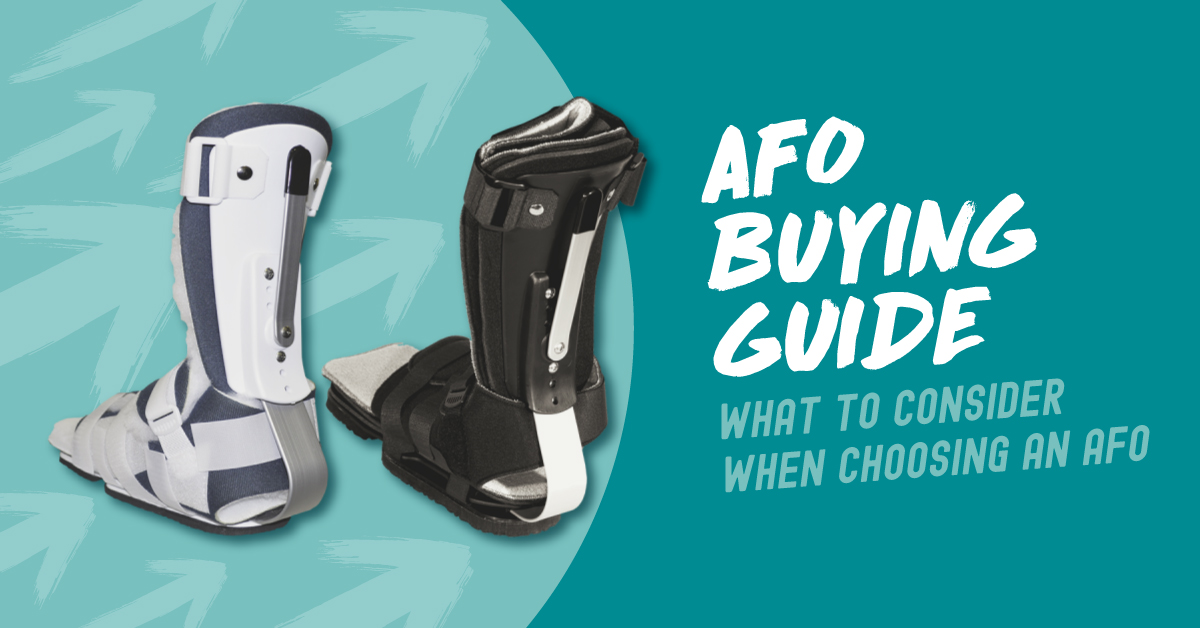
Developing patient treatment plans is like buying a pair of jeans or choosing a vehicle – it's no one-size-fits-all approach, and brand matters.
You care for many patients. And, each one's condition, limitations, needs, and goals are different. You can't follow a cookie-cutter treatment plan and hope for the best. Customized treatment programs are typically the only way to achieve optimal health outcomes.
We recommend that same customized approach when choosing an Ankle-Foot Orthosis (AFO) as part of your patient's rehabilitation, recovery, and pain management plan. Various factors should impact your decision on whether an AFO will help, and if it will, which one works best for a specific patient.
AFO Basics
An AFO is a device that improves patients' walking patterns by reducing, preventing, or limiting the lower leg and foot movement by supporting weak muscles. They help maintain joint alignment, accommodate deformity and reduce spasticity.
An AFO extends above the ankle to the top of the calf and is worn with shoes and socks. It is fastened at the lower leg, just above the ankle.
The device is sometimes considered medically necessary for patients with weakness or deformity of the foot and ankle and when the patient can benefit functionally from its use.
AFOs are best used to treat your patients struggling with disorders or diseases like:
- Ankle dorsiflexion (upward motion)
- Plantar Fasciitis (downward movement)
- Inversion and eversion (turning inward or outward)
- Spastic diplegia due to cerebral palsy
- Lower motor neuron weakness due to poliomyelitis
- Spastic hemiplegia with cerebral infarction
- Diabetic neuropathy
- Foot drop (commonly caused by ALS, multiple sclerosis, cerebral palsy)
- Foot/ankle contracture (unable to lift the top of the foot)
AFOs protect the injured area, help facilitate safe and comfortable healing of the heel, ankle, or foot, and aid in pain management.
What to Consider When Choosing an AFO
One of the biggest reasons AFOs are a valuable part of lower extremity care is because they are versatile enough to help with many different conditions. That versatility also means there is a diverse selection of AFOs for physicians and patients to choose from.
AFOs are available in several different formats, shapes, strengths, and sizes. Finding the right AFO for your patient's needs can be challenging but not impossible. We collaborate with healthcare professionals to provide resources and information that allow them to make the most educated decisions possible when choosing an AFO best suited for treatment.
Here are a few essential tips to consider when selecting the right AFO for your patient:
Size and Shape
Just like buying shoes or clothing, size, and shape matter when choosing an AFO. They are available in multiple formats. Some are thin and cover only a small part of the foot and ankle. Others are thicker and surround the entire ankle and foot.
Your patient's condition and needs will help determine which foot coverage is necessary. You'll want to address this point with your patient, their therapist, and other treatment team members before purchasing an AFO.
AFO Construction
AFOs have different compositions; that is, they are made of different materials. Typically, basic AFOs are made from a durable but lightweight plastic that supports the foot while remaining light enough to allow easy mobility. These are designed to enable the patient to maintain as much mobility and independence as possible during recovery.
Other AFOs are constructed of thick fabric or metal that integrates with the plastic portions of the boot. These boots are usually slightly heavier than the lighter plastic ones but provide more foot coverage and protection for the patient. These AFOs sometimes work best for those with severe conditions and those with more lower body strength who may require a more robust AFO.
Shoe or No Shoe Usage
Most AFOs have one of two possible formats. In the first format, the boot is light and thin, allowing the patient to wear it with a regular walking shoe for rehabilitative purpose.
Other boots that surround the foot more extensively are designed to be both the supportive boot for ambulation and rest. Depending on your patient's condition, you may want to recommend one format over the other.
Maintenance and Replaceable Parts
Patients with AFOs use them almost round the clock. So, they must be very durable and able to stand up to normal wear and tear. But even the most well-constructed AFO will need to be maintained.
Part of keeping them in proper working condition means having access to replacement parts when needed. When choosing an AFO, make sure your patient can get replacement straps and clasps, which tend to experience the most wear. Also, some manufacturers offer other replacement parts or a new boot itself that can be purchased later. Recovery takes time, so your patient should be able to keep their AFO in constant working order by getting replacement parts when needed.
Choosing a Reputable Brand
There are many AFO manufacturers in the world. As a leading provider of prefabricated and custom-made medical devices for upper and lower extremity needs, Anatomical Concepts takes a multi-disciplinary treatment approach working directly with orthotists, physical therapists, and physicians.
We help them develop customized treatment plans, rehabilitation schedules, and bracing programs to solve complex biomechanical deficiencies. ACI offers a variety of AFO devices to treat many conditions and diseases.
 330-757-3569
330-757-3569





